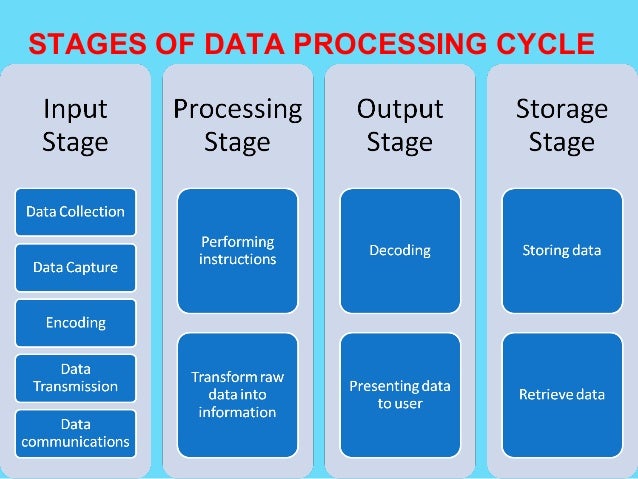The absence of a unique approach of distinguishing Data processing and Data Communication features is complicating the Federal Communications Commission`s Second Computer Inquiry and developing weather of uncertainty within the teleprocessing industry. This article proposes an easy mathematical criterion for distinguishing among those lessons of features, illustrates its application, and discusses related regulatory coverage issues.
You might be asking what is Data Processing or how is it relevant in our day-to-day activities?
Data processing is the collection and conversion of potentially useful raw data into a desired usable form. In this sense, it can be considered a subset of information processing, "the change of information in any manner detectable by an observer."
Data on its own is raw, and it can not be used for any purposes unless it is 'gather together' ( collection ), 'completely analyze' ( Conversion ) into a desired usable form. The process or methods in which this is carried out in a predefined cycle of operations either manually or automatically.
Before that, let us take a look at the Cycles of Data Processing.
The data processing cycle is a synchronized set of operatives used to convert raw data into useful information.
Stage 1: The Input stage
This is where the raw data is collected and captured, which is prepared to be transmitted to the processing stage.
Stage 2: The Processing stage
This is where the collected raw data is been processed by means of; electronic data processing, mechanical processing, or automated means. The processed data here is the end-user information. It can't be understood unless it is properly processed.
Stage 3: The Output stage
This is the closing step of the data processing cycle because the processed information is brought within the shape of information/consequences on this step. Once the end result or output is received, it is able to in addition be processed or interpreted. This is completed via way of means of the consumer or software program for in addition price addition. This output also can be used at once in shows or records. This output may also be stored for use as an entry for additional information processing which then will become part of a cycle that's being discussed. If this information isn't used as entering, then this entire procedure can't be taken into consideration as a cycle and could continue to be a one-time interest of information processing. For the use of this information is entered, it needs to be saved or concurrently be to be had for in additional processing.
Stage 4: The Storage stage
The very last stage of data processing is the storage stage. After all the data are processed, its miles are then saved for future use. While a few facts can be placed to apply immediately, lots of it'll serve as a motive later on. Plus, well-saved statistics are a need for compliance with statistics safety regulations like GDPR. When statistics is well saved, it may be speedy and effortlessly accessed via way of means of individuals of the company while needed.
What makes the processing of data important or How is it related to our day-to-day activities??
Nowadays, an increasing number of data is accrued for academic, clinical research, private & private use, institutional use, business use. This accrued data desires to be stored, sorted, filtered, examine, and offered or even require information switch for it to be of any use. This system may be easy or complicated relying on the dimensions at which series is achieved and the complexity of the outcomes which might be required to be obtained.
The time fed on in acquiring the favored end result relies upon the operations which want to be done at the accrued information and on the character of the output document required to be obtained. This hassle turns into a starker whilst coping with the very huge extent of information.

